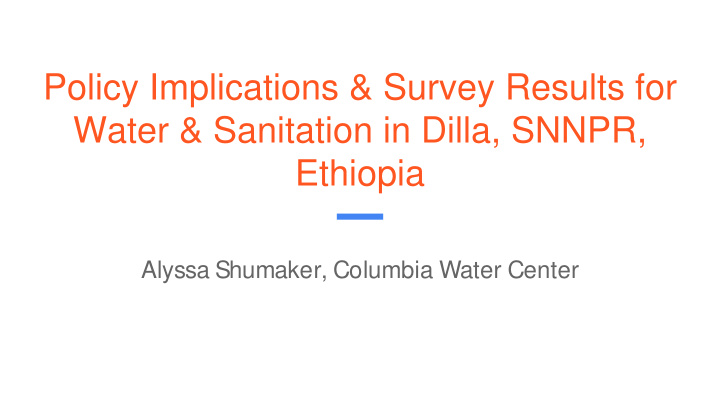



Policy Implications & Survey Results for Water & Sanitation in Dilla, SNNPR, Ethiopia Alyssa Shumaker, Columbia Water Center
Introduction to Ethiopia Problem Description & Data Collection Methods Agenda Analysis Proposed Solution Challenges & Next Steps 2
Introduction to Ethiopia 3
Ethiopia: Facts and Figures Located in the Sub-Saharan “Horn of Africa” Slightly twice the size of Texas Population is 96 million Up to 60% of the current disease burden in Ethiopia is attributable to poor sanitation Approximately 21 ,000 Ethiopian children die each year from diarrhea An Ethiopian child is 30 times more likely to die by his or her fifth birthday than a child in Western Europe 4
Political Situation 5
6
Case Study and Subject: Dilla, SNNPR • Population approximately 1 00,000 • 369 km from Addis Ababa • Exports: Coffee, meat; fruits • Contains University, Hospital, capital of Gedeo Zone • Major water source: Chichu River 7
Peace Corps Volunteer, 2012 - 2014 8
Problem Description & Data Collection Methods 9
Data Collection Periods in Dilla over Time 201 2 201 4 201 6 10
2013 71 Survey Participants ● Needs Analysis ● Findings: ○ Water Scarcity Top Need ○ 4 of 5 top morbidity rates adults & children water-related 11
2014, Literature 1 32 Households Findings: 75% of HH do not have piped water when desired Alternatives: water vendors, rivers, or hand dug 25% of HH Diarrheal Disease Willingness to pay for 20-liter jerry can per household between .1 9 and .21 cents ETB 12
2016 ● 1 62 Survey Participants ○ 5 Areas of the City ○ Analyzed: Water collection, water use, purchasing decisions; costing mechanisms � Stakeholder Analysis, Interviews, Focus Groups, Qualitative Research Collection also conducted � Findings: ○ Water Treatment Plant supplies 30,000/1 00,000 ○ Water treated inconsistently with chlorine ○ Recent cholera epidemic ○ Hospital still cites 4 of 5 outpatient disease water-related ○ 85% of HH willing to pay between 2 and 3 ETB for jerry can, 1 4x greater than in 201 4 13
Above: Storage tanker at Dilla Treatment Plant Left: Water treatment chlorination process 14
Analysis 15
Monthly Precipitation Overlay 1981 - 2016 16 Graph, Pierre Cruikshank
Monthly Average Precipitation 17 Graph, Pierre Cruikshank
Proposed Solution 18
Problem Tracing Lack of Water No Investment in Water Problems in Lack of Rain Lack of Funds at Supply and Potential Dilla, SNNPR Water Harvesting Key Locations Storage Technology Increase Possess Improve the Water Increased Awareness and Additional Water Invest Funds at Situation in Dilla, Rainwater Investment in Storage and Key Locations SNNPR Harvesting Potential Supply Technology 19
Supplemented Water Targeting Key Locations for Maximum Impact Cost: approx. $2000/tanker Materials readily available and wide range of use Easy to install Low treatment required Water in Dilla low in chloroforms, lacking fluoride, nitrates, and nitrites Manual and some implementation done at 20 Health Centers by UNICEF
Health Center Statistics Catchment Area: 69,000 people On average, 1 20 patients seen per day Main source of water: piped water Average water/week used 3,000 liters UNICEF minimum recommended 4,000 liters/day Services affected by lack of water: deliveries, sanitation services, and availability of drinking water Storage is limited to 1 ,000L tanker Roof approximately 1 50 m 2 21 Directly above: Dilla Hospital Administration Building
Dilla Town Health Center 14 m 2 4 m 2 Total Approximate Size: 153 m 2 16 m 2 4 4 m 2 m 2 22
Rainwater Harvesting Options and Demand Implications Tank Size (liters) Winter Spring Summer Fall Yearly ● 1 52m 2 rooftop � .7 capture efficiency 2,500 38 76 63 46 56 � First flush filter 225 liters 5,000 43 87 76 58 66 every time over 3 days 10,000 44 92 86 70 73 no rain 12,500 44 92 89 74 75 � Demand 428L/day 23
Intervention + Sustainability Objective 1 Increase water quantity and access through self-sustaining rainwater harvesting installations in SNNPR, Ethiopia Objective 2 Increase health access and effective treatment through more sanitary facilities and cleaner water 24
Challenges & Next Steps 25
Challenges Unknown price points Lack of known partners and/or international NGOs working in the area Communication Seasonal variability Circumventing the problem, not fixing the root problem (infrastructure) Hard to determine use of health center as water scarcity now contributes to inaccurate use Maintenance and sustainability plans 26
Next steps Field Visit in June, 201 7 Establish Feasibility, Identify Partners, Verify Data 27
Implications of Political Situation No major NGO working on water needs in the south Aligns with complaints from marginalized communities “Charities and Societies Proclamation” limits NGO involvement Major road to Dilla has been under construction for over 2 years, pushing a 2 hour drive into a 3 hour drive 28 Photo, CNN
Thank You & Questions 29
Annex 1. Problem Tree 30
Annex 2: Dilla Town Treatment Plant 31 Above: Beginning of Intake Process
Annex 2. Rainwater Roof Culture 32 Photo and Culture, Mark Brotman
Annex 3. CNN Clip 33
Recommend
More recommend